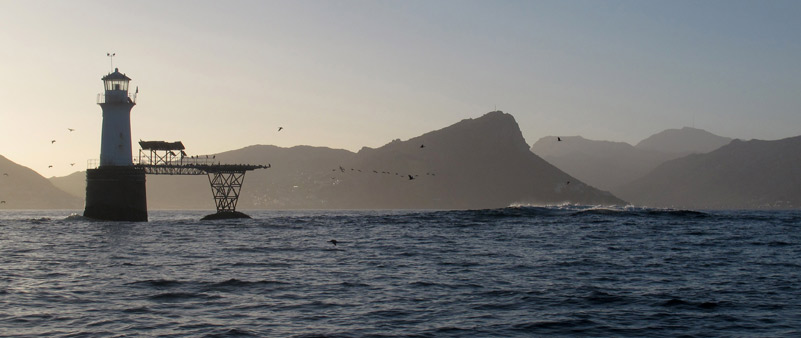Every time I go out to sea with African Shark Eco Charters on our cage diving tours I’m struck by the beauty of False Bay, it’s changing moods, its light and colour and its stories and I hope that this little bit of history of Roman Rock lighthouse helps to enhance your experience with us – it’s not only about great white sharks!
Standing alone in the sea on the approach to Simonstown harbour is Roman Rock Lighthouse.
We pass Roman Rock lighthouse almost daily on our cage diving trips to SealIsland in search of great white sharks. I’m always struck by its changing moods – sometimes it appears as a welcoming light for weary sailors approaching home and the comfort of a safe harbour, sometimes it looms gothic and foreboding, a symbol of danger, conjuring images of shipwreck and disaster.
Roman Rock Lighthouse is the only lighthouse in South Africa (and one of only a few worldwide) built on an offshore rock and completely surrounded by water. The lighthouse provides a great photographic focal point that adds depth and scale to photographs of the bay. Our guests on the shark diving boat frequently ask about it’s history so I thought I’d write a little of it here.
On the 16 September 1861 the Roman Rock lighthouse shone its first light after four years of construction that allowed only 96 working days of calm sea. Construction was undertaken by the shipping community of Simonstown who felt the need of a light to be so great that they offered to build it if the colonial government would maintain it.
Stone was quarried from Seaforth beach, assembled there and numbered, before being ferried out to the site. The cast-iron segments of the tower itself were prefabricated in England, shipped out and then bolted together in-situ.
The base of the lighthouse is washed by waves even at low tides so the initial design allowed for a circular trench cut into the rock as the foundation and for the first three metres to be filled with concrete. Despite this cracks soon appeared and the structure was then strengthened with wrought-iron hoops. However, with the structural integrity of the lighthouse in question the colonial government would not assume control and the responsibility for manning the lighthouse until their engineers were satisfied with its construction.
The base was then further reinforced with a 4 ft. granite wall cladding of blocks estimated at 3 tonnes each and a granite and Portland cement fill. The lighthouse was then finally handed over to the department of public works on the 28 February 1867.
Roman Rock lighthouse keepers manned the light in 7 day shifts and were amongst the highest paid in the service on account of the light’s isolation. The first keeper, Mr. J. Williams eared £110 per annum and his assistants £95 per annum. In 1914, a gas powered light was installed and since then the lighthouse has been unmanned.
Further refurbishment was completed in March 1992 with the laying of a four-core 25 mm submarine cable to power the a new rotating beacon to a candlepower of 147 656 cd with a range of twenty sea miles at a period of 1 flash every 6 seconds.






